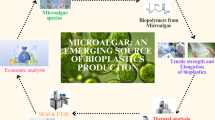Abstract
This study not only presents the results of our own experiments in alga production, but also shows the expected economic results of the various uses of algae (animal feed, direct burning, pelleting, bio-diesel production), the technical characteristics of a new pelleting method based on literature, and also our own recommended alga production technology. In our opinion, the most promising alternative could be the production of alga species with high levels of oil content, which are suitable for utilization as by-products for animal feed and in the production of bio-diesel, as well as for use in waste water management and as a flue gas additive. Based on the data from our laboratory experiments, of the four species we analyzed, Chlorella vulgaris should be considered the most promising species for use in large-scale experiments. Taking expenses into account, our results demonstrate that the use of algae for burning technology purposes results in a significant loss under the current economic conditions; however, the utilization of algae for feeding and bio-diesel purposes—in spite of their innovative nature—is nearing the level needed for competitiveness. By using the alga production technology recommended by us and described in the present study in detail, with an investment of 545 to 727 thousand EUR/ha, this technology should be able to achieve approximately 0–29 thousand EUR/ha net income, depending on size. More favorable values emerge in the case of the 1-ha (larger) size, thanks to the significant savings on fixed costs (depreciation and personnel costs).


Similar content being viewed by others
References
Wilkie AC, Mulbry WW (2002) Recovery of dairy manure nutrients by benthic freshwater algae. Bioresour Technol 84(1):81–91. doi:10.1016/S0960-8524(02)00003-2
Kim J, Lingaraju BP, Rheaume R, Lee JY, Siddiqui KF (2010) Removal of ammonia from wastewater effluent by Chlorella vulgaris. Tshinghua Science and Technology 15(4):391–396. doi:10.1016/S1007-0214(10)70078-X
Lim SL, Chu WL, Phang SM (2010) Use of Chlorella vulgaris for bioremediation of textile wastewater. Bioresour Technol 101(19):7314–7322. doi:10.1016/j.biortech.2010.04.092
González LE, Cañizares RO, Baena S (1997) Efficiency of ammonia and phosphorus removal from a Columbian agroindustrial wastewater by the microalgae Chlorella vulgaris and Scenedesmus dimorphus. Bioresour Technol 60(3):259–262. doi:10.1016/S0960-8524(97)00029-1
Mulbry W, Kondrad S, Pizarro C, Kebede-Westhead E (2008) Treatment of dairy manure effluent using freshwater algae: algal productivity and recovery of manure nutrients using pilot-scale algal turf scrubbers. Biorescour Technol 99(17):8137–8142. doi:10.1016/j.biortech.2008.03.073
Narsi S (2011) Oilgae comprehensive report. A detailed guide for algae biofuels. www.oilgae.com/ref/report/report.html. Accessed 8 June 2011
Sambamurty AVSS (2005) A textbook of algae. I K International, New Delhi
Bergman P C A, Kiel J H A (2005) Torrefaction for biomass upgrading, ECN report, ECN-RX-05-180 doi:www.ieabcc.nl/meetings/task32_Berlin_ws_system_perspectives/03_Kiel.pdf. Accessed 8 June 2011
Prins MJ, Ptasinski KJ, Janssen J (2006) More efficient biomass gasification via torrefaction. Energy ECOS 2004—17th International Conference on Efficiency, Costs, Optimization, Simulation, and Environmental Impact of Energy on Process Systems 31 (15): 3458–3470 doi:10.1016/j.energy.2006.03.008
Peng JH, Bi HT, Sokhansanj S, Lim JC, Melin S (2010) An economical and market analysis of Canadian wood pellets. Int J Green Energ 7(2):128–142. doi:10.1080/15435071003673518
Ghezelbash F, Farboodnia T, Heidari R, Agh N (2008) Biochemical effects of different salinities and luminance on green microalgae Tetraselmis chuii. Research Journal of Biological Sciences 3(2):217–221. doi:10.3923/rjbsci.2008.217.221
Seyfabadi J, Ramezanpour Z, Khoeyi ZA (2010) Protein, fatty acid and pigment content of Chlorella vulgaris under different light regimes. J Appl Phycol. doi:10.1007/s10811-010-9569-8
Nábrádi A (2002) Fertilization management. In Bai (ed) Use of biomass. Szaktudás, Budapest, pp. 30–37
Nábrádi A (2007) The economic value of grassland products. APSTRACT 1(1):19–28. doi:ageconsearch.umn.edu/bitstream/43572/2/a2.pdf
Molnár Zs, Pájtli P, Keresztessyné MK (2009) Cereals and industrial plants. Agriculture market report. https://www.aki.gov.hu/download/gabona_07_17_pdf/483. Accessed 8 June 2011
Barka E, Bartha T, Halmai O, Szabó T, Vigassy Cs (2010) Annual Report. Hungarian Energy Office. http://www.eh.gov.hu/gcpdocs/201012/tajekoztato_2009_web.pdf. Accessed 8 June 2011
Stündl L, Bársony P, Herpergel Z, Fehér M (2010) in Bai A (Ed) Complex economic analysis of our algae experiments including a case study. Final study of the project titled “Development of algae production in animal sludge for energy and feeding. Economic modelling” (ATEBIOEN, 2009–2010). Baross Gábor Research Program. Debrecen, pp. 1–73
Kiel J H A, Verhoeff F, Gerhauser H, Meuleman B (2008) BO2-technology for biomass upgrading into solid fuel-pilot-scale testing and market implementation. Energy Research Centre of the Netherlands (ECN). http://www.ecn.nl/docs/library/report/2008/m08036.pdfBO2
Németh A (2009) Economic and technological review of biomass conversion technologies and economic feasibility analysis of torrefied pellet production in Hungary. MSc thesis, Wageningen University
Narsi S (2010) The algae energy industry. Opportunities and prospects. Oilgae Digest. www.oilgae.com/ref/report/digest/digest.html#k_t_aways. Accessed 8 June 2011
Sevrin-Reyssac J (1998) Biotreatment of swine manure by production of aquatic valuable biomasses. Agr Ecosyst Environ 68(3):177–186. doi:10.1016/S0167-8809(97)00070-4
Author information
Authors and Affiliations
Corresponding author
Rights and permissions
About this article
Cite this article
Bai, A., Jobbágy, P. & Durkó, E. Algae production for energy and foddering. Biomass Conv. Bioref. 1, 163–171 (2011). https://doi.org/10.1007/s13399-011-0015-1
Received:
Revised:
Accepted:
Published:
Issue Date:
DOI: https://doi.org/10.1007/s13399-011-0015-1




